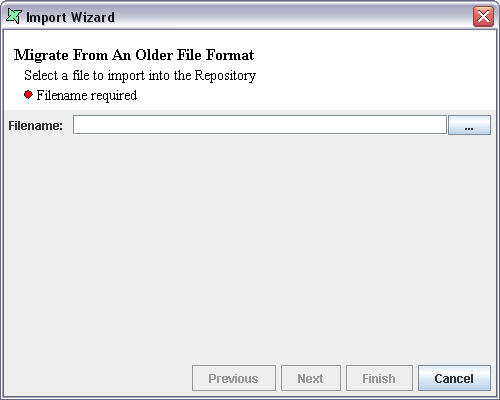Right clicking any entry from the Repository tree, alows you to add new files and file systems. Each menu item launches a wizard to guide you through the process.
CSS
CSS is used to create and edit a Cascading Style Sheets file. It can define the styles of a report, including background, fonts, headers and footers.
Connection Pool
A Connection Pool allows connections to JDBC databases and
connection properties to be shared among multiple datasources.
Connection Pools are described in the Elixir Data Designer User Manual.
DataSource
DataSource is the principal building block in an Elixir
Repertoire solution. External data may be wrapped as a DataSource
and multiple DataSources may be merged and processed by a
Composite DataSource. Each type of DataSource is described in
the Elixir Data Designer User Manual.
HTML
HTML is used to create and edit a Hypertext Markup Language file. HTML can be imported into a Dashboard and embedded in a Frame or Page.
JavaScript
Elixir Repertoire is an extensible tool, allowing users familiar with Java or JavaScript to integrate the tool with their code or customize the tool to meet their own requirements. Many parts of the tool allow JavaScript to be embedded. However, if the same scripts are required in multiple locations it is preferable to create a common JavaScript file in the repository and then import it into each DataSource, Report or Dashboard that requires it. This editor is discussed further in Chapter 4, Elixir JavaScript Editor.
Job
Job is used to add tasks that are intended to run together.
Map
A Map is a visual representation of geographic areas and adds new dimensions to
data visualisation. More information about Map can be found in the Elixir Map
Designer documentation.
Report Template
A Report Template holds the specification for a report, including
the layout of report components and references to the datasources
needed to provide the data during rendering. Reports are stored in
Report Markup Language (with XML syntax), with a file extension .rml.
Report Templates are described in the Elixir Report Designer User Manual.
Safe
A Safe is an encrypted text file, used for holding valuable text-based information, such as database and passwords. The Safe is described in Chapter 3, Elixir Safe.
Text
A simple text editor/viewer is included for reviewing log files and CSV data.
Universe
A Universe is an interface to data. You can add more than one Universe to handle higher-volume data processing. Universes hold many tables. There are two types of Universes: Repository and JDBC. In the Repository Universe, each table maps to a DataSource. Universes can exist anywhere in the Repository, but are only accessible when mapped to a Universe name. All modules that use Universe reference the universe name instead of the path. This enables you to easily switch between different Universes by re-mapping. Universe mapping is a feature only available for administrators.
XML
XML is used to create and edit an Extensible Markup Language file. It can be imported into DataSources and pass the data.
Regardless of the type of file system, each has a name. This name
must be unique as it forms the base for each repository path. For
example, if a file system called FS contains a datasource called mine.ds,
then the full name of the datasource is /FS/mine.ds. Elixir Repository
always uses / for path separators, like URLs, regardless of the platform on which it is running.
Anywhere a URL can be specified, you can use the special protocol
repository: to refer to files. For example, the URL
repository:/FS/mine.ds
refers to the datasource described above.
You can add, remove and delete file systems from the Domain Manager. For more information, refer to the
Domain Manager User Manual..
After adding a file system to the Repository, different files, for example DataSources, Dashboards, Reports and Folders can be added to it.
Each file system, folder and file has a popup menu showing the available actions. File systems and folders have similar options:
Add: Using this menu item, several kinds of files or a folder can be added. Each will invoke a specialized wizard to guide you through the creation process.
Import: Import allows files to be imported into the repository. This option is for files that need some migration or extraction to be used in the Repertoire tool. Primarily this option is used for Elixir Report 4 .sav and .template files.
Choose a file system or folder into which the data source or template should be imported, and select Import from the popup menu. The "Import Wizard" appears as shown in Figure 2.3, “Import Wizard”. You can use the browse button to choose the file to be imported. On clicking Finish, the file gets imported into the repository. A .sav file contains many datasources, so each will become a separate
.dsfile in the chosen location.Note
It is only necessary to import files from Elixir Report prior to version 5.0. Version 5.0 and later files can be read by the tool without any special import/extraction/migration step.
Refresh: (Only applies to file systems, not folders.) On selecting this option the file system will be refreshed and any changes to the files and folders made using tools other than Repertoire, will be visible.
Remove: A file system or folder can be removed from the repository when this menu item is selected.
Delete: A file or folder can be deleted from the file system when this menu item is selected. Delete actually only hides the file by giving it a .bak extension. Files and folders with .bak extensions are hidden from Repository views, but can be restored (if you made a mistake) by renaming them using operating system commands. To permanently delete a file or folder, you should Compact after deleting, which will remove all .bak files. Refer to the
Domain Manager User Manualfor compacting a file system.

